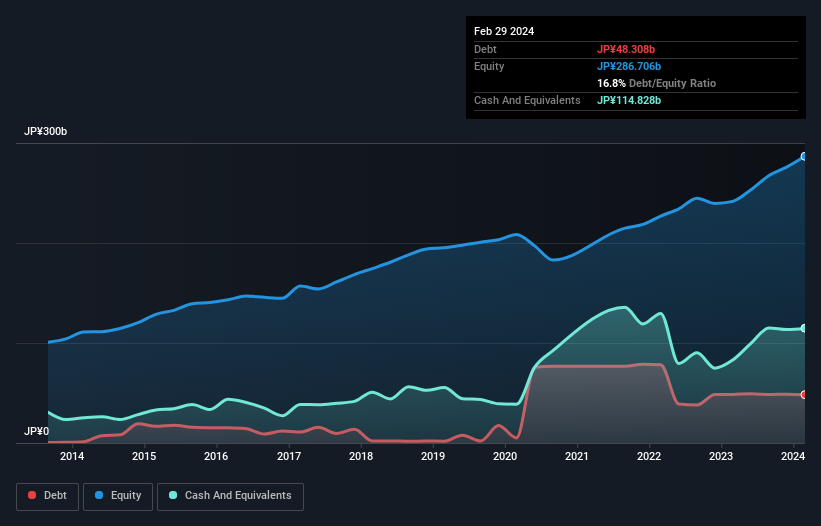Is Ryohin Keikaku (TSE:7453) Using Too Much Debt?

David Iben put it well when he said, 'Volatility is not a risk we care about. What we care about is avoiding the permanent loss of capital.' So it seems the smart money knows that debt - which is usually involved in bankruptcies - is a very important factor, when you assess how risky a company is. We can see that Ryohin Keikaku Co., Ltd. (TSE:7453) does use debt in its business. But the real question is whether this debt is making the company risky.
When Is Debt A Problem?
Debt and other liabilities become risky for a business when it cannot easily fulfill those obligations, either with free cash flow or by raising capital at an attractive price. If things get really bad, the lenders can take control of the business. While that is not too common, we often do see indebted companies permanently diluting shareholders because lenders force them to raise capital at a distressed price. Of course, plenty of companies use debt to fund growth, without any negative consequences. When we examine debt levels, we first consider both cash and debt levels, together.
View our latest analysis for Ryohin Keikaku
What Is Ryohin Keikaku's Debt?
The chart below, which you can click on for greater detail, shows that Ryohin Keikaku had JP¥48.3b in debt in February 2024; about the same as the year before. However, it does have JP¥114.8b in cash offsetting this, leading to net cash of JP¥66.5b.

A Look At Ryohin Keikaku's Liabilities
We can see from the most recent balance sheet that Ryohin Keikaku had liabilities of JP¥127.0b falling due within a year, and liabilities of JP¥67.4b due beyond that. On the other hand, it had cash of JP¥114.8b and JP¥25.5b worth of receivables due within a year. So its liabilities total JP¥54.0b more than the combination of its cash and short-term receivables.
Since publicly traded Ryohin Keikaku shares are worth a total of JP¥717.6b, it seems unlikely that this level of liabilities would be a major threat. However, we do think it is worth keeping an eye on its balance sheet strength, as it may change over time. While it does have liabilities worth noting, Ryohin Keikaku also has more cash than debt, so we're pretty confident it can manage its debt safely.
On top of that, Ryohin Keikaku grew its EBIT by 95% over the last twelve months, and that growth will make it easier to handle its debt. When analysing debt levels, the balance sheet is the obvious place to start. But it is future earnings, more than anything, that will determine Ryohin Keikaku's ability to maintain a healthy balance sheet going forward. So if you want to see what the professionals think, you might find this free report on analyst profit forecasts to be interesting.
Finally, while the tax-man may adore accounting profits, lenders only accept cold hard cash. Ryohin Keikaku may have net cash on the balance sheet, but it is still interesting to look at how well the business converts its earnings before interest and tax (EBIT) to free cash flow, because that will influence both its need for, and its capacity to manage debt. Over the most recent three years, Ryohin Keikaku recorded free cash flow worth 53% of its EBIT, which is around normal, given free cash flow excludes interest and tax. This cold hard cash means it can reduce its debt when it wants to.
Summing Up
We could understand if investors are concerned about Ryohin Keikaku's liabilities, but we can be reassured by the fact it has has net cash of JP¥66.5b. And we liked the look of last year's 95% year-on-year EBIT growth. So we don't think Ryohin Keikaku's use of debt is risky. Over time, share prices tend to follow earnings per share, so if you're interested in Ryohin Keikaku, you may well want to click here to check an interactive graph of its earnings per share history.
At the end of the day, it's often better to focus on companies that are free from net debt. You can access our special list of such companies (all with a track record of profit growth). It's free.
New: AI Stock Screener & Alerts
Our new AI Stock Screener scans the market every day to uncover opportunities.
• Dividend Powerhouses (3%+ Yield)
• Undervalued Small Caps with Insider Buying
• High growth Tech and AI Companies
Or build your own from over 50 metrics.
Have feedback on this article? Concerned about the content? Get in touch with us directly. Alternatively, email editorial-team (at) simplywallst.com.
This article by Simply Wall St is general in nature. We provide commentary based on historical data and analyst forecasts only using an unbiased methodology and our articles are not intended to be financial advice. It does not constitute a recommendation to buy or sell any stock, and does not take account of your objectives, or your financial situation. We aim to bring you long-term focused analysis driven by fundamental data. Note that our analysis may not factor in the latest price-sensitive company announcements or qualitative material. Simply Wall St has no position in any stocks mentioned.
Have feedback on this article? Concerned about the content? Get in touch with us directly. Alternatively, email editorial-team@simplywallst.com
About TSE:7453
Ryohin Keikaku
Develops, manufactures, distributes, and sells apparel, household goods, and food items in Japan and internationally.
Solid track record with excellent balance sheet.


